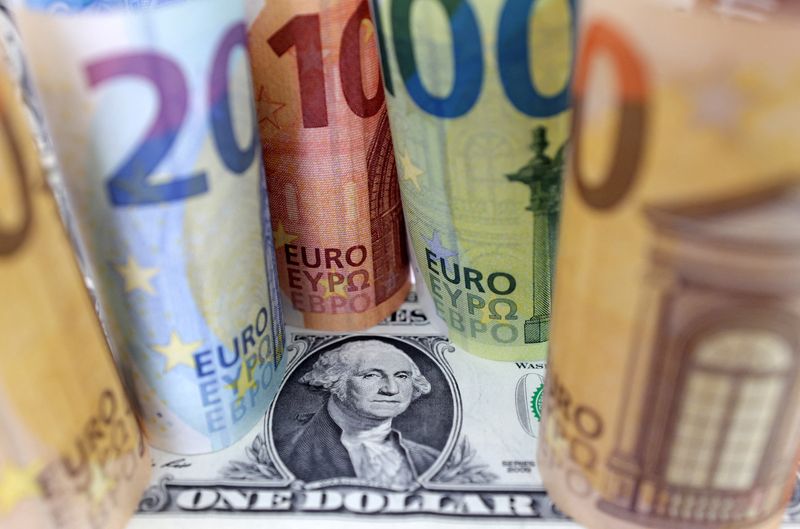Forex
Analysis – Dollar slump, overcrowding complicate popular FX carry trade


© Reuters. FILE PHOTO: U.S. Dollar and Euro banknotes are seen in this illustration taken July 17, 2022. REUTERS/Dado Ruvic/Illustration
By Harry Robertson, Alun John and Ankur Banerjee
LONDON/SINGAPORE (Reuters) – A slide in the dollar and signs that volatility is returning to foreign exchange markets as interest-rate hikes bite is causing investors to reassess wildly popular carry trades and to be pickier about which currencies they back.
The carry trade – an investment strategy that takes advantage of differences in borrowing costs between countries – has provided bumper returns this year as most central banks have hiked rates, causing yields to rise, but at different paces.
“The world’s favourite carry trade,” according to Bank of America, involves investors borrowing Japanese yen where the central bank has pinned rates low, and converting them to to buy much higher-yielding bonds.
bond yields are about 0.1% in negative territory in Japan, but their yield around 11%.
A hypothetical $50,000 invested in a short , long peso carry trade for the first six months of the year would have yielded a profit of $15,100, according to Refinitiv Eikon.
“Carry has been very much in focus in the first half of the year,” said Kamakshya Trivedi, head of global FX, rates and EM strategy at Goldman Sachs. “Something like 70% of the cross section of moves (in EM currencies) can be explained by carry.”
Deutsche Bank’s emerging market carry strategy index had its best year on record in the 12 months to May.
But the trade could be jolted this week as the Federal Reserve, European Central Bank and Bank of Japan all set interest rates and give clues on the monetary policy outlook.
OVERCROWDING FEARS
Investors, however, are becoming concerned the carry trade might be becoming too popular for its own good.
“You have to be worried about some of these more crowded positions,” said Stephen Gallo, European head of FX strategy at BMO Capital Markets.
Gallo said a pick-up in market volatility or a fall in EM interest rates could trigger a rush for the exits.
James Athey, investment director at abrdn, said: “Things like the Mexican peso have been heavily positioned for quite some time, it’s sort of felt like you’re increasingly picking up pennies in front of a steamroller.”
Volatility matters, as an appreciation in the currency in which investors borrow, or a depreciation in the one in which they invest, can wipe out gains from yield differentials.
The yen has already hinted at snapping back, firming from 145 per dollar to 137 in the first half of July.
“I think that is big enough to offset any carry trade income,” said Yujiro Goto, head of FX strategy for Japan at Nomura.
Volatility has been low so far this year because most central banks have been raising interest rates broadly in tandem and nothing major has broken in the global economy, said Oliver Brennan, FX volatility strategist at BNP Paribas.
Now, things look different: the Fed looks set to pause, the Bank of England still has ground to cover, some emerging market central banks are considering cuts, and the Bank of Japan is keeping traders guessing.
The volatility of the world’s five most-traded currencies fell to its lowest in a year and a half in June, according to CME Group’s options-based volatility gauge, but has since ticked higher.
“From here, the risk is there is less (policy) convergence and more uncertainty,” Brennan said.
THE DOLLAR SLIDES
Emerging markets haven’t been the only focus. Investors have also flocked to higher U.S. bond yields compared to many countries by going “long” on the dollar.
Yet the has slid 2% against a basket of major currencies this month so far, after a sharp slowdown in U.S. inflation in June raised hopes that the Federal Reserve is approaching its final interest rate hike.
This “benign disinflation” in the U.S. may help dollar-funded emerging market carry trades continue to do well, said Robin Winkler, FX strategist at Deutsche Bank.
“In G10, however, the negative USD turn is not necessarily positive for carry, seeing as the USD has been a favored long,” he said.
“Japan’s yen in particular, but also the Swiss franc and Swedish or Norwegian crowns, have been used as funding currencies for USD longs for a long time,” he said. “As a result, these USD pairs have come under heavy pressure.”
A hypothetical $50,000 invested in a short Norwegian crown, long dollar carry trade in the first three weeks of July would have lost $3,000, according to Refinitiv.
Goldman’s Trivedi said carry trades can still reap rewards, particularly if emerging markets are boosted by Chinese stimulus. He recommended not simply picking the highest-yielding currencies, however.
“Adding currencies that have quite a lot of cyclical exposure makes sense, because in a world in which growth is going to be stronger… that includes things like the in Latin America or the in Asia.”
Geoff Yu, market strategist at BNY Mellon, said the outlook was relatively benign but remained uncertain.
“Just be selective right now,” he said. “You just don’t want to basically double up, or triple up, on risk exposure.”

 Forex3 years ago
Forex3 years agoForex Today: the dollar is gaining strength amid gloomy sentiment at the start of the Fed’s week

 Forex3 years ago
Forex3 years agoUnbiased review of Pocket Option broker

 Forex3 years ago
Forex3 years agoDollar to pound sterling exchange rate today: Pound plummeted to its lowest since 1985

 Forex3 years ago
Forex3 years agoHow is the Australian dollar doing today?

 Cryptocurrency3 years ago
Cryptocurrency3 years agoWhat happened in the crypto market – current events today

 World3 years ago
World3 years agoWhy are modern video games an art form?

 Commodities3 years ago
Commodities3 years agoCopper continues to fall in price on expectations of lower demand in China

 Economy3 years ago
Economy3 years agoCrude oil tankers double in price due to EU anti-Russian sanctions





















